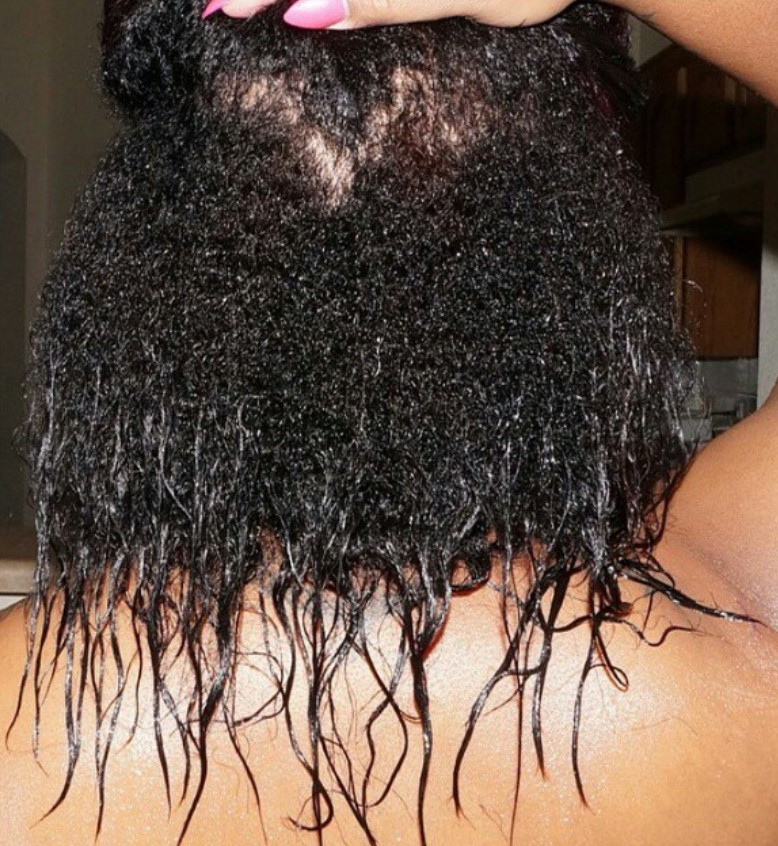Transitioning from relaxed to natural hair is not an easy process. If you have been thinking of converting relaxed hair to natural hair, then you are not alone. Thousands of Black women want to embrace their natural textures, but they fail to recognize both the emotional struggle and the powerful experience of this journey. A hair change during this journey transforms you into someone different from what you were before.
A hidden aspect of transitioning from relaxed to natural hair is that the process presents difficulties, but having the right knowledge can help you in successfully navigating this process. However, in this article I will cover some of the myths and facts about transitioning from relaxed to natural hair. Below is a texture shot of transitioning hair.

credits: @hydratherma (via Instagram)
1. It’s Not Just Physical—It’s Emotional
Let’s be honest. The process of moving from relaxed hair to natural hair creates a deeply personal transformation for every person. Relaxed hair became an expression of “neatness” and “professionalism”, or even “beauty norms” that many women never actively selected for themselves. The process of releasing this can produce feelings of freedom, yet simultaneously induce fear.
Your changing texture during the transition period will create self-doubt regarding your appearance. You might get unsolicited opinions. That’s normal. You need to remember that you are freeing yourself from years of learned habits in both your emotions and your hair.
2. The Line of Demarcation Is Real (And Fragile)
When you’re transitioning without the big chop, your hair will have two different textures: relaxed ends and natural roots. The point where these textures meet is called the line of demarcation, and it’s extremely fragile.
The hair breaks easily when you handle it with improper care. You should avoid hair styles that both pull on your roots and need excessive handling. Protective hairstyles including bantu knots together with braid-outs and twist-outs serve to merge your different hair textures while decreasing tension.
3. Wash Days Will Change (And That’s Okay)
Gone are the days of quick wash-and-go routines. Transitioning hair requires patience. Detangling can take longer, and you’ll need to use products that cater to both textures.
The ideal products for transitioning from relaxed to natural hair include sulfate-free shampoos combined with hydrating deep conditioners and leave-in treatments which provide slip and moisture. Proper hair care products minimize damage while making it simpler to handle different hair textures.
Recommended Products:
• SheaMoisture Raw Shea Butter Restorative Conditioner – Great for moisture and detangling.
• Mielle Organics Babassu Oil Deep Conditioner – Helps soften new growth.
• TGIN Green Tea Leave-In Conditioner – Ideal for daily hydration and easy detangling.
4. Your Hair Will Talk to You—Learn Its Language
Relaxed hair received training as a result of its care but natural hair exists as a separate entity. The roots will begin to form curls while your hair demonstrates separate reactions toward moisture heat and product applications.
Begin to learn about your hair preferences. When transitioning your hair from relaxed to natural without cutting it off you need to conduct testing sessions. Try new routines. Keep a hair journal. The process requires time because you need to learn what your hair demands.
5. Breakage Might Happen (Don’t Panic)
Yes, breakage can occur—and yes, it’s scary. The experience of hair breakage stands as a typical occurrence during this time. You should never equate breakage with being a failure.
Your focus should remain on achieving equilibrium between protein and moisture content in your hair. Hair becomes weak and mushy when you provide excessive moisture without enough protein. The application of excessive protein to hair makes it brittle while insufficient protein results in weak and mushy hair.
Use protein treatments once monthly when your hair develops excessive softness or limpness. The transitioning phase of hair care often utilizes Aphogee 2-Minute Keratin Reconstructor as a preferred product.
6. Heat Can Be a Friend or Foe
Flat ironing your hair while transitioning serves to merge textures yet excessive heat usage creates potential damage to your hair. Using heat requires you to apply a protective treatment followed by moderate temperature settings.
Try heatless styling methods that include flexi rods and curlformers and braid-outs instead of using heat tools. Using these styling methods protects your hair while you discover the natural beauty of your curl pattern.
7. You Don’t Have to Big Chop
The common notion that you need to cut your hair entirely for natural hair transition is incorrect because many women successfully transition without cutting it off. The decision to start fresh is not the only valid option because transitioning over an extended period is both possible and usually more comfortable.
Women often choose to let their relaxed hair grow from 6 months up to more than 1 year before starting to cut off the relaxed ends. The gradual pace of this process enables you to maintain your length as you learn to handle your natural hair.
8. Community and Representation Matter
The transition process becomes very lonely when those around you do not comprehend natural hair care. That’s why community is key.
Follow natural hair influencers and join Facebook groups or watch YouTube channels that share relaxed to natural hair journey stories. The journey will teach you new skills while providing both creative ideas and essential help.
Final Thoughts
Natural hair transition beyond the process of allowing your curls to grow longer. Natural hair growth represents a combination of self-care practices together with personal discovery and occasionally it functions as a rebellion against societal beauty standards.
Each person has their unique approach to transitioning between relaxed and natural hair care. Your natural hair transformation holds value whether you decide to cut off all your hair at once or take a gradual approach. The right mindset combined with proper products and support enables you to thrive throughout your entire journey.
Your crown is growing—wear it proudly.
